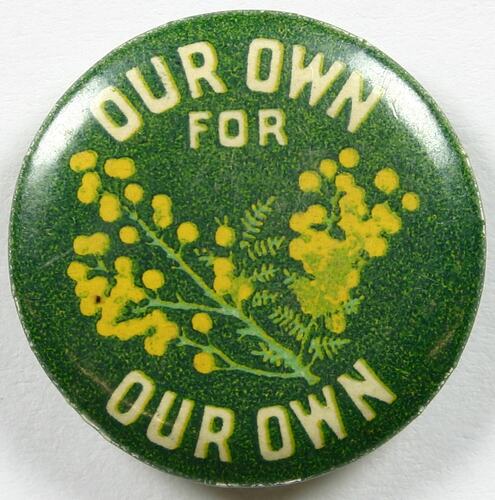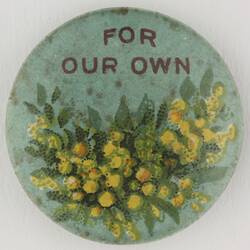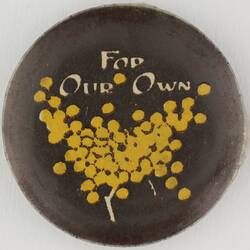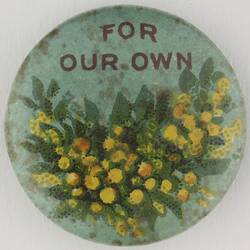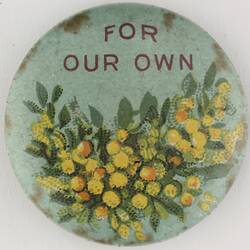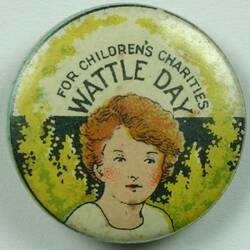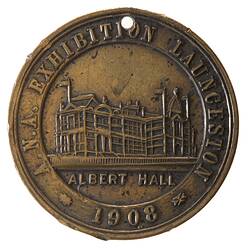Summary
Alternative Name(s): Button
Wattle Day badge, 1915. Its design is identified by Pezikian & Anderson (2017:16) as issued for the September 1915 Wattle Day fundraising drive to raise money for children's charities. To support the event, trucks decorated with wattle blossoms paraded Melbourne's streets. The Age reported that over £2600 was raised (probably in Melbourne alone (3/9/1915, p.8).
The first 'national' Wattle Day was celebrated in Sydney, Melbourne and Adelaide on 1 September 1910. Wattle had become a symbol of Australia with the approach of Federation. It was particularly promoted by the Australian Natives' Association, established in Melbourne in 1871 as a non-partisan and non-sectarian friendly society for Australian-born, white men seeking to shape Australia's nationhood and identity. The ANA was a strong advocate for Federation and became an advocate for White Australia. It was a staunch supporter of trade protection and immigration restriction, and Prime Minister Alfred Deakin was a member. Public support for Wattle Day peaked during World War I, when it was a potent symbol of home for military personnel serving overseas, and a means of raising money for organisations such as the Red Cross. Beautifully designed Wattle Day badges as well as wattle sprigs were sold. The influence of Wattle Day waned as the 20th century progressed, but in 1992 the Governor-General declared 1 September National Wattle Day.
Physical Description
Circular pressed metal badge with a plastic cover on the obverse, a metal back, and an attached pin. Off-white text and an illustration in yellow, green and light green ink appears on the obverse. In the centre, there is an illustration of a branch of wattle branches on a green background. Off-white text also appears on the bottom rim of the badge, but is partly obscured by the pressed fold of the obverse onto the metal back. The badge is discoloured and soiled. There are stains on the obverse. The reverse of the badge is tarnished, and the original gold colour has partly worn away.
More Information
-
Collection Names
-
Collecting Areas
-
Acquisition Information
Donation from Mrs Betty Laurie, by Dec 1986
-
Date Created
-
Organiser of Event
Australian Natives' Association (ANA)
Wattle Day was an initiative of the Australian Natives Association (ANA) and the Wattle Blossom League. -
Organiser of Event
Wattle Blossom League
Wattle Day was an initiative of the Australian Natives Association (ANA) and the Wattle Blossom League. -
Date of Event
-
Inscriptions
Printed: "OUR OWN/ FOR/ OUR OWN"
-
Classification
-
Category
-
Discipline
-
Type of item
-
Overall Dimensions
4 mm (Depth), 23 mm (Outside Diameter)
-
Dimensions
4 mm (Depth), 22 mm (Outside Diameter)
Measurement From Conservation.
-
References
[Link 1] Viewed 7.5.09. [Link 2] Viewed 7.5.09. [Link 3] Viewed 7.5.09. WATTLE DAY. (1915, September 3). The Age (Melbourne, Vic. : 1854 - 1954), p. 8. Retrieved March 6, 2019, from [Link 4]
[Book] Pezikian, Nick & Andersen, David. 2017. Commonwealth Button Fund: WWI Patriotic & Fundraising Badges., 16 Pages
-
Keywords
Community Organisations & Services, Environmental Activism, Fundraising, Wattle Day, World War I Fundraising
